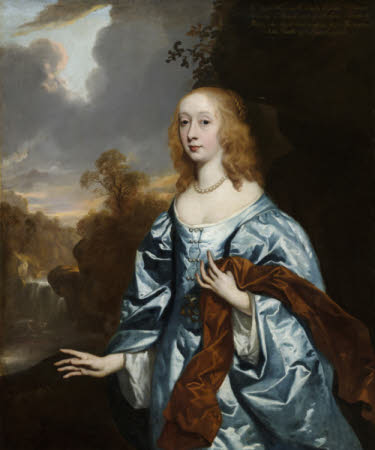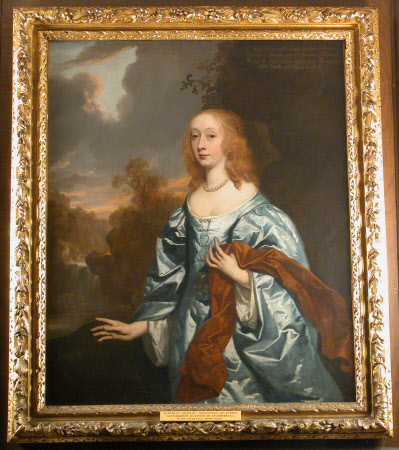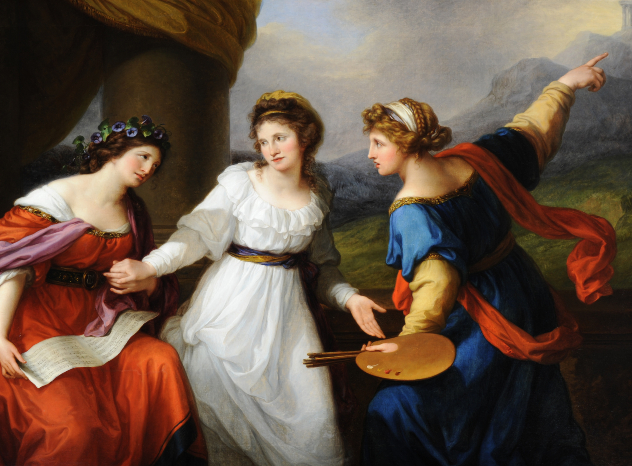Elizabeth Murray, Countess of Dysart, later Duchess of Lauderdale (1626-1698)
Sir Peter Lely (Soest 1618 – London 1680)
Category
Art / Oil paintings
Date
1648
Materials
Oil on canvas
Measurements
1219 x 978 mm (48 x 38 1/2 in)
Order this imageCollection
Ham House, Surrey
NT 1139764
Summary
Oil painting on canvas, Elizabeth Murray, Countess of Dysart, later successively Lady Tollemache and Duchess of Lauderdale (1626-1698) by Sir Peter Lely (Soest 1618 – London 1680), painted in the year of her marriage to Lionel Tollemache, 1648. A three-quarter-length portrait of Elizabeth Murray as a young woman, turned to left, gazing at the spectator, wearing low cut blue satin dress over white undership (shown at neckline and inner sleeves). The dress is fastened down the bodice with five rows of triple pearls culminating at the waist with a ribboned bow. A brown silk /satin scarf is held in her left hand. She wears a single rope pearl necklace, high on the neck. Red hair, falling softly to the shoulders and dressed at the back with a crown of plait. To left, wild landscape background with rocks and trees. She gestures with her right hand towards the central feature of the landscape, a waterfall. The cloudy sky, the rocks and trees are all depicted in a pink glow of late evening.
Full description
A young woman walking in a wooded landscape gestures behind her, past the silhouetted rocky outcrop that emphasises her pale skin, towards a waterfall and a darkening sky, the gathering clouds lit by a distant sunset. She is Elizabeth Murray, one of the most intriguing women in seventeenth-century Britain, Countess of Dysart in her own right and later Duchess of Lauderdale. A powerful and, at times, unscrupulous player in the politics of the Commonwealth and at the Restoration court, she was also an important patron of the arts. She played a key role in supporting the Dutch émigré painter Peter Lely (Pieter van der Faes), who would become Charles II’s principal painter, and the chief image maker of later seventeenth-century England. Lely was a hugely successful and influential artist. His success resulted in having to employ a large number of studio assistants to help meet the demand for his portraits; the country houses of Britain have many portraits by him or from his studio, or by artists painting in his style. His success also meant that he had the financial means to purchase art and he had one of the largest and most important collections in England. Samuel Pepys sometimes visited the artist’s studio and, in his diary entry for 25 March 1667, wrote ‘… called at Mr. Lillys’, who was working; and indeed his pictures are without doubt much beyond Mr. Hales’s, I think I may say I am convinced: but a mighty proud man he is, and full of state’. Lely was born Pieter van der Faes, in 1618, to Dutch parents in the garrison town of Soest in Westphalia. He trained under Frans Pietersz de Grebber in Haarlem, where he was enrolled at the Guild of St Luke there in 1637. He travelled to England in the 1640s, where he initially painted subject pictures (possibly to set himself up as a picture dealer) of mythological, pastoral, musical and religious scenes, but ‘finding the practice of Painting after the Life generally more encourag’d, he apply’d himself to Portraits’. He soon came to be considered the finest portraitist in England, painting prominent members of the Commonwealth regime during the interregnum, including Oliver Cromwell (1599–1658),3 and soon after the Restoration, in 1660, being created Charles II’s principal painter. Elizabeth Murray was one of Lely’s most important patrons, and he painted various portraits of her and her family members, fellow Scottish courtiers and political allies, with which she furnished the Long Gallery at Ham House, her Thames-side home near Richmond in Surrey, where it ‘as a whole demonstrated most vividly how such portraits were assembled and displayed by Lely’s patrons’. One such friend and compatriot, the sitter in a recently re-identified Lely portrait of c.1630–1681 at Ham, was John Leslie, Duke of Rothes ( NT 1139951). A fellow Scot, fighting for the restoration of the monarchy after Charles I’s execution, he is depicted as a Royalist soldier with a huge red sash over his cuirass and buff coat. He was captured following the Royalist defeat at the Battle of Worcester in 1651, the last battle of the English Civil War, as was the duchess’s second husband, John Maitland, then Earl of Lauderdale, and both of them were imprisoned in the Tower of London. Being a prominent courtier, especially after her marriage to Maitland, soon, in 1672, to be created Duke of Lauderdale, one of Charles II’s most trusted ministers and secretary of state for Scotland, meant that Ham would have been a highly visible location for other courtiers and visitors, who would have marveled at her display of Lely portraits. It was also at Ham that she would have displayed her other pictures by Dutch artists, such as those by Abraham Bloemaert (NT 1140058) Ambrosius Bosschaert (NT 1140187) and Frans Post (NT 1139908). Of the four Lely portraits of Elizabeth Murray that are still at Ham the present picture is the earliest, painted in 1648, around the time of her first marriage, to Sir Lionel Tollemache (1624–1669). It was painted only a few years after an early description of her as ‘a pretty one but for her deep coullerd hayer … such a pretty witty Lass, with such a brave house & ’state as she is like to have, m’thinks might make a young fellowe think’ her hayer very beautifull …. She seems to be a very good harmless vertuouse witty little bable.’ In her later years, she and her second husband were famous for their greed and political corruption, and a friend turned enemy, Gilbert Burnet, Bishop of Salisbury (1643–1715), noted she was ‘a violent friend, but a much more violent enemy. She had a restless ambition, lived at a vast expense and was ravenously covetous, and would have stuck at nothing by which she might compass her ends’. Despite the bucolic tone of the portrait the sitter is not shown playing an Arcadian role; instead the depiction concentrates on her social status. She is shown wearing a fashionable, jewelled and waistless ‘night-gown’, with dressed hair and posing elegantly, set against the untamed natural world behind her, complete with a turbulent waterfall. The pastoral setting is reminiscent of those in Lely’s subject pictures, painted not long before the present portrait. Elizabeth continued to patronise Lely throughout his career, commissioning works from the 1640s until possibly 1680, the year of his death. There are three other Lely portraits of Elizabeth at Ham, comprising a double portrait of her c.1651 with an unidentified, and possibly enslaved attendant (NT 1139940), a double portrait with the duke, painted around 1675 (NT 1139789); and the last single portrait of her, painted c.1680 (NT 1139783), where she is shown with a fashionable head-on-hand pose, with her hair worn modishly loose down one side, like an ageing Venus at her toilet. (David Taylor, 2018) Adapted from 'Prized Possessions: Dutch Paintings from National Trust Houses' (exh. cat.), 2018, pp. 118–21, cat. 12.
Provenance
At Ham House by 1683; thence by descent; acquired by HM Government when Sir Lyonel Tollemache, 4th Baronet and Sir Cecil Tollemache, 5th Baronet gave Ham House to the National Trust in 1948; entrusted to the care of the Victoria and Albert Museum until 1990, when returned to the National Trust; ownership transferred to the National Trust in 2002.
Credit line
Ham House, The Dysart Collection (purchased by HM Government in 1948 and transferred to the National Trust in 2002)
Makers and roles
Sir Peter Lely (Soest 1618 – London 1680), artist
References
Prized Possessions: Dutch Paintings from National Trust Houses (exh. cat.), Holburne Museum, Bath 25 May - 16 Sep 2018; Mauritshuis, The Hague, 11 Oct 2018 - 6 Jan 2019; Petworth House, West Sussex, 26 Jan - 24 Mar 2019., pp.118-21, no.12


